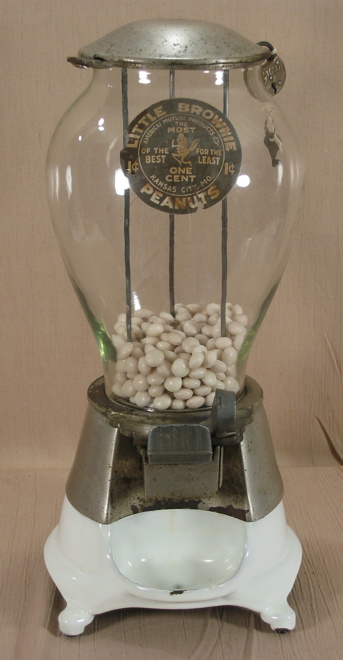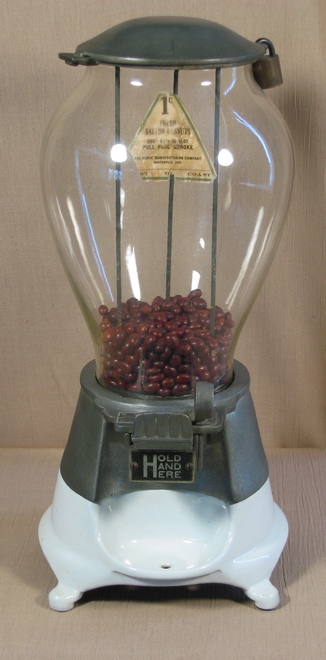___________________________________________________________________________________________
Hance Standard Rex


(Click on image to enlarge it)
___________________________________________________________________________________________


(Click on image to enlarge it)
Hance Mfg. Co., Westerville, OH, c. 1910's or 1920's, 18". The date range is an estimate. The Standard Rex was part of Hance's "White Base" line. The base is porcelainized cast iron, and the nonporcelainized pieces are either nickel-plated cast iron or aluminum. Put a penny into the coin entry, pull the handle out, and a handful or peanuts or candy will drop into your hand. The handle is spring-loaded, so it retracts and awaits the next customer. A coin door on the back of the base is secured with a tab lock that's riveted to the coin door, so the vendor could simply take the door off to get to the money inside.
I'll admit my bias here: I think this is an awesome tall-globe vendor with a lot going for it. As with most tall-globe vendors, it's a relatively big machine with a lot of presence. I like the white porcelain base and the overall symmetry of the design. It's a well-balanced look. This is a desirable machine that I used to think was pretty scarce, but I've seen enough by now to think that they're not too uncommon.
On this model more than many others, what distinguishes machines are the specific characteristics of each particular one. The "best" examples are 100% original, have an original decal, and have a great old patina. Very few of the examples I've seen had decals, and many have been buffed or have recast parts. The base on this model has been reproduced, so be sure you're buying an original machine before you plunk down "original machine" money.
According to Silent Salesmen Too, Hance also made a nickel version of this machine. One of the 2 examples pictured in that book is a nickel version with a tall coin entry, but I don't know if the tall coin entry designated a nickel machine or if that's just a coincidental combination of these features that Bill happened to photograph. I don't recall ever seeing a nickel version or one with the taller coin entry, so I don't know the relationship (if any) between them.
I believe that this model evolved in at least 2 respects. One is the type of metal used for the nonporcelainized parts, and the other is in the appearance of tags on the midsection. I believe that the earliest examples had a nickel-plated cast iron midsection and lid, and that the midsection was plain and without tags. The machine pictured above on the left is one of these. At some point Hance switched to aluminum for midsection and lid, and I believe the earliest of these may have also had a plain midsection with no tags. Then Hance added a tag affixed flat to the top of the midsection behind the handle. The machine pictured above on the right has one of these, which on this machine reads "The Hance Mfg. Co., Specialty Manufacturers, Westerville, Ohio, U.S.A, Mach. No. 4048." You can see part of this tag just to the left of the handle, but unfortunatly the handle hides most of the tag in the picture above. The next variation also has this tag, but also has another tag affixed to the front of the midsection, which reads "Hold Hand Here." This tag is also present on the machine pictured above on the right. So in essence, I believe that Hance started this machine with a cast iron midsection and lid with no tags, switched the midsection and lid material to aluminum, and then added one tag and then a second tag as the model evolved. I remember hearing (although I don't remember where) that Hance made this model from the late 1910's through the late 1920's, so it makes sense that they altered things during the model's life cycle. Compared to other models by other manufacturers, these changes were minor and didn't appear to involve any new castings or do-dads. In that respect this model stayed pretty consistent throughout its lifespan.
Both of the examples pictured above are 100% original. I'm not sure the locks pictured are correct for this model, but the eras are consistent. According to my hypothesized evolution of this model, the example on the left is one of the earliest to be made while the example on the right is one of the latest to be made.
___________________________________________________________________________________________
___________________________________________________________________________________________
©Small Vintage Vending 2003-2009